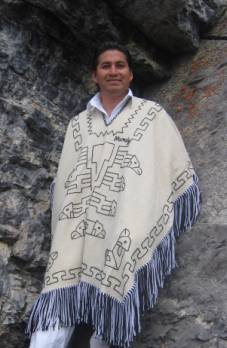
Marcelo Soria and Nuna'Y
 |
Marcelo
Soria grew up in a house filled with music in Cochabamba, Bolivia.
He is proficient with all the traditional Andean instruments, but
specializes in the charango and vocals. He founded the group Nuna'Y
in Calgary with the goal of bringing Andean music and Bolivian culture to
Canada.
|
Music of the Andes
Andean music comes from the approximate area inhabited by the Incas prior to European contact. It includes the countries
Bolivia, Peru, Ecuador, Southern Columbia, and Northern Chile and Argentina.
Wind and percussion instruments are known to have existed even prior to the Incas, but musical evolution peaked with the Incan empire. The arrival of the Spaniards in the 16th century brought string instruments and new forms, spurring the invention of the distinctive charango
in the Bolivian city of Potosi, a stringed instrument similar to a lute.
Panpipes (zampoña) are an ancient indigenous instrument that comes in multiple varieties. Some modern panpipes are capable of playing a full scale, and are used as solo instruments, while traditional panpipes were played in pairs; this is still commonplace with two performers sharing a melody. Quenas (notched-end flutes) remain popular, and are traditionally made out of
bamboo Quenas are generally only played during the dry season, while vertical flutes called tarkas taking over in the wet. Marching bands dominated by drums and panpipes are commonplace, and are used to celebrate weddings and other holidays.
Out of all the Andean countries, Bolivia remains perhaps the most culturally linked to the indigenous peoples. Like most of its neighbors, Bolivia was long dominated by Spain and its attendant culture. Even after independence, Bolivian music was largely based on European forms. In 1952, a revolution established nationalistic reforms granting increased social, cultural and political awareness for the Aymara and Quechua natives. Intellectuals in the country began wearing ponchos and otherwise associating themselves with native cultures, and the new government promoted native folklore by, among other methods, establishing a folklore department in the Ministry of Education.
Bolivia
.svg/125px-Flag_of_Bolivia_(state).svg.png) |
Bolivia is a landlocked nation; it lost its connection to the Pacific coast in the War of the Pacific in 1879. However, it does have access to the Atlantic via the Paraguay river. The west of Bolivia is situated in the Andes mountain range, with the highest peak, Nevado Del Sajama at 6,542 metres (21,463 ft). The west of the country is formed by a highland plateau, the Altiplano. The east of the country is lowland, and covered by the Amazonian rainforests. Lake Titicaca is located on the border between Bolivia and Peru. In the west, in the department of Potosí, lies the Salar de Uyuni, the world's largest salt flats. |
Major cities are La Paz, Santa Cruz de la Sierra and Cochabamba.
Bolivian culture has many Inca, Aymara and other native influences in religion, music and clothing, depending upon the region of the country, isolation of the cultures and contact with European (Spanish) culture. The best known fiesta is the UNESCO heritage "El carnaval de Oruro". Entertainment includes football, which is the national sport, played in many street corners. Also, zoos are a popular attraction with a diverse population of interesting creatures.